Writing copy is tough.
Writing persuasive copy is even tougher.
When you need to persuade someone through writing, you can feel lost:
- Which words should you use?
- How should you frame the offer?
- How do you sell without appearing sleazy?
I hear ya.
Luckily, copywriting is an art AND science. In this article, you’ll learn 31 copywriting tips — based on academic research — that will maximize the persuasiveness of any message.
Do you prefer to learn through video? I give more copywriting advice in my course platform: School of Mind.
Conveying Your Message
Persuasion isn’t the only goal of copywriting. In this part, you’ll learn how to convey your message in the clearest, most effective way possible.
Side note: all of the illustrations in this article will reference a hypothetical productivity app that you created. Hopefully the consistent example will help you apply the tactics to your own projects.
Resources for Overachievers:
- Everybody Writes: Your Go-To Guide to Creating Ridiculously Good Content — Ann Handley
- How Long Should Your Pages Be? — Joanna Wiebe
- How to Create a Deep Connection With Your Prospects and Customers — Sonia Simone
- What to Do When Your Writing Sucks — Ivy Shelden
Boost the Clarity
When your writing is unnecessarily complex, readers perceive you to be less intelligent (Oppenheimer, 2006).
You can thank processing fluency.
If you have trouble processing written content, your brain experiences a negative emotion. It then misattributes that negative emotion to the content that you’re reading.
To increase the fluency of your copy — and to prevent those harmful evaluations — you need to simplify your message. In this section, you’ll learn a few research-backed techniques to boost the clarity (and persuasiveness) of your writing.
Tactic 1: Choose Active Voice (Over Passive Voice)
In passive sentences, the subject is the recipient of the action. In active sentences, the subject performs the action.
- PASSIVE: Some interesting tactics are explained in this article.
- ACTIVE: This article explains some interesting tactics.
Active sentences are more persuasive. Why? Hosman (2002) explains that passive sentences are grammatically complex, thereby weakening persuasion…
“Sentences with more complex grammatical structures [are] more difficult to understand or comprehend. This comprehension difficulty could affect the persuasion process negatively, presumably because comprehension is an antecedent to persuasion…” (pp. 373)
Active sentences increase processing fluency. Because readers can digest your message more easily, they experience a positive emotion (which they misattribute to your copy).

Tactic 2: Describe Information Using Positive Frames
Negative frames describe an absence — what isn’t happening. Positive frames, on the other hand, describe something more tangible.
- NEGATIVE: Don’t be late.
- POSITIVE: Arrive on time.
- NEGATIVE: Don’t drink excessively.
- POSITIVE: Drink responsibly.
- NEGATIVE: Don’t use negative frames.
- POSITIVE: Use positive frames.
Since we need more mental resources to process negative frames, they reduce comprehension and degrade the impact of your message (Jacoby, Nelson, & Hoyer, 1982).
You can use negative frames occasionally. That’s normal. But you should use positive frames for the majority of your sentences.

Tactic 3: Add Coherence Markers Throughout Your Copy
Consider two versions of an ad for Dove (see Kamalski, 2007):
- Your skin’s natural oils keep it silky and supple. As you age, it becomes less elastic and the production of oil slows down. Aging can cause dull, dehydrated skin.
- Your skin’s natural oils keep it silky and supple. But as you age, your skin becomes less elastic and the production of oil slows down. That is why aging can cause dull, dehydrated skin.
Those passages illustrate coherence markers.
COHERENCE MARKERS – Words and phrases that connect ideas
You can use coherence markers in two ways:
- REFERENTIAL COHERENCE – You describe an object that you referenced in a previous sentence (e.g., the second Dove passage changes “it” to “your skin”)
- RELATIONAL COHERENCE – You convey a causal connection (e.g., but, therefore, so, as a result, that is why, consequently)
Most advertisers remove coherence markers because they don’t add semantic meaning.
However, research shows that coherence markers boost clarity and persuasion (Kamalski, 2007). So keep those subtle words and phrases throughout your copy (like the “so” at the beginning of this sentence).

Tactic 4: Maximize the Diversity of Your Word Choices
Hosman (2002) explains the connection between persuasion and lexical diversity. Readers prefer messages that contain a variety of different words.
In particular, he emphasizes the type-token ratio (TTR):

“A low TTR means that a speaker’s vocabulary is relatively redundant, while a high TTR means that it is relatively diverse.” (Hosman, 2002, pp. 374)
Readers perceive messages with a high TTR to be more interesting. And they evaluate communicators more favorably.
You should still avoid complex language. Just incorporate simple — yet varied — word choices.
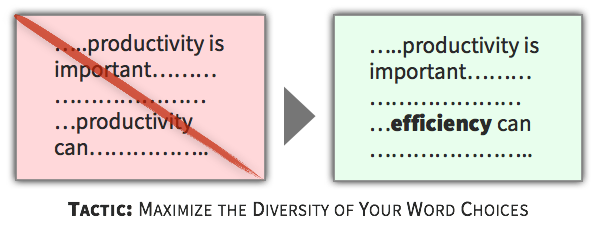
Provide a Concrete Mental Image
Words are meaningless. On the surface, they represent arbitrary symbols — a mere conduit that conveys our meaning.
Images, on the other hand, don’t require translation. Their meaning is immediate. Not surprisingly, images generate a larger emotional impact than words (Hinojosa et al., 2009).
To increase the persuasiveness of your content, you should transform important written content into a mental image. How can you do that? This section will teach you a few techniques.
Tactic 5: Use Metaphors to Convey Intangible Concepts
Given the importance of concrete features, you’ll notice a problem when it comes to marketing. Try to visualize the following features:
- Quality
- Powerful
- Reliable
Having trouble? Me too. You can’t visualize intangible concepts. And your readers share the same difficulty.
That’s where metaphors can help. For example…
“…life insurance companies use ideas associated with various symbols such as umbrellas (Travelers), rocks (Prudential Insurance Company), and hands (Allstate) to convey qualities of protection, sturdiness, and support” (Zaltman, 2008, p. 35).
Metaphors tangibilize the intangible. They provide your readers with a concrete mental image, enhancing the impact and persuasiveness of your message (Sopory & Dillard, 2002).
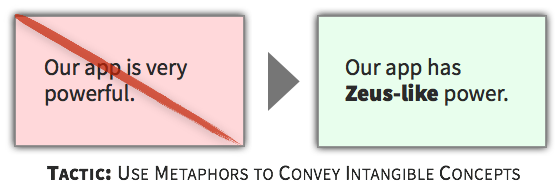
Tactic 6: Transform Generic Claims into Concrete Terms
Generic claims are the plague. They’re everywhere.
(thumbs up to anyone who recognized the coincidentally timed metaphor)
Everywhere you look, you find statements like…
- Our support team is very quick
- Our customers love us
- Our software is very reliable
Yada yada yada.
Don’t get me wrong — the underlying messages are great. But it sounds like you’re selling, rather than telling.
Watch what happens when you transform those generic claims into concrete terms:
- We’ll get you an answer within 24 hours
- 568 companies love our software
- You’ll have 100 percent uptime…guaranteed.
Suddenly your message becomes more believable and persuasive. In this case, you’re telling, rather than selling.
When possible, you should also incorporate large numbers. According to a study by Startup Moon, headlines with large numbers are more likely to go viral.
So don’t talk about the security flaw that harms “many” WordPress users. Do a quick search for the actual number of websites:
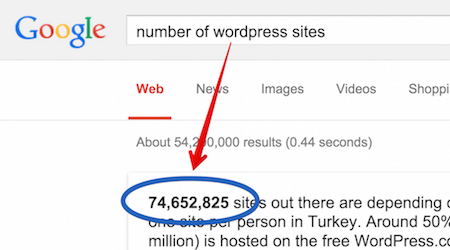
Now you have a better headline: 75 Million Websites Are Vulnerable to a Security Flaw in WordPress.
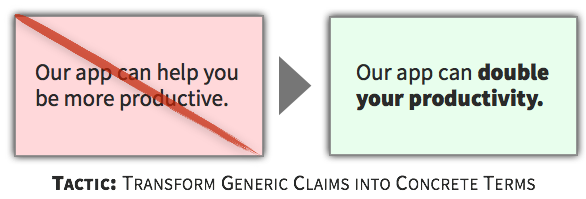
Tactic 7: Convey Percentages in Terms of People
When we provide statistics, we’re usually trying to emphasize the importance of an issue.
Slovic, Monahan, and MacGregor (2000) examined the role of framing in percentages. They gave the following messages to separate groups of clinicians:
- FRAME 1: Patients similar to Mr. Jones are estimated to have a 20% chance of committing an act of violence.
- FRAME 2: 20 out of 100 patients similar to Mr. Jones are estimated to commit an act of violence.
Both messages are essentially the same. However, twice as many clinicians refused to discharge the patient in FRAME 2.
To maximize the impact of your statistics, you should convey percentages in terms of people:
- DON’T SAY: 90 percent of people
- SAY THIS: 9 out of 10 people

Tactic 8: Depict Familiar or Emotion-Inducing Perspectives
Describing a story? Then you need to choose a perspective:
- INSIDER: “John came into…”
- OUTSIDER: “John went into…”
So…which is better?
You need to consider two factors: familiarity and emotion.
If your main goal is comprehension, then choose the perspective that generates the most familiarity with readers.
Consider these sentences:
- SENTENCE 1: The man went into the prison
- SENTENCE 2: The man came into the prison
If you’ve never been to prison, then SENTENCE 1 — the outside perspective — will be more effective (Jiang & Wyer, 2009). Since that framing is congruent with your experience, it increases processing fluency.
But what if you’re trying to generate an impact on readers? In that case, choose the perspective aligned with the most emotion.
Consider these sentences:
- SENTENCE 1: The robber went into the bank
- SENTENCE 2: The robber came into the bank
In SENTENCE 2, readers construct the mental image based on the perspective of bank customers — the emotional perspective. So that sentence generates a stronger impact (Jiang & Wyer, 2009).
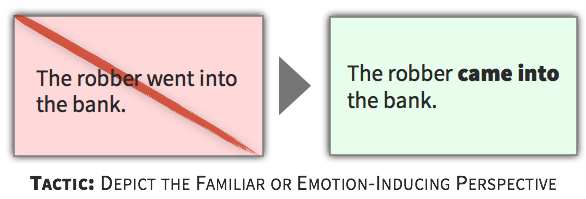
Tactic 9: Emphasize Tangible Uses for Leftover Savings
Do you offer a low-priced product? Then you could mention the amount of money that customers could save:
- Save $215 each year
- Reduce costs by 15{11064b5fcb42990caf99fbbde3221f4b4a59d98cf45d0bc9c34fdbe4de1fd93a}
And those are good…but they’re intangible. So they could be better.
Frederick et al. (2009) recommend emphasizing specific uses for that leftover cash:
“…firms may better promote low-price products by cueing consumers to think about the leftover cash and possible attractive uses for it. For example, Volkswagen could emphasize the economy of purchasing their vehicle in terms of the new wardrobe of clothes one would then be able to afford...” (Frederick et al.,, 2009, pp. 559-560)
In turn, the savings become tangible. Customers can visualize the benefits. So they’re more likely to appreciate the value of your offering.
The same concept applies with time:
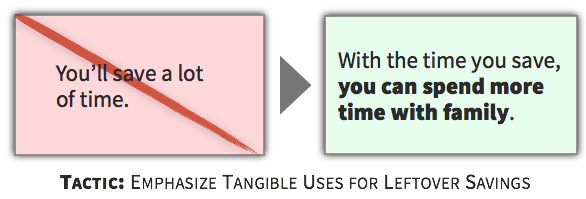
You could also emphasize a hedonic alternative (e.g., vacation). Those alternatives will be more persuasive (see my article on choice psychology).
Tactic 10: Transform Numeric Information into Semantic Visuals
Our brain has trouble evaluating numeric information:
“Numeric information in general may be more difficult to evaluate because it is abstract, its meaning changes dramatically from one context to another (9°F versus 9 billion dollars versus 9% wrong on an exam), and numbers are often used to convey small, unfamiliar differences.” (Peters et al., 2009, pp. 4)
When possible, transform numerical attributes into a semantic visual.
For example, Peters et al., (2009) found that people could evaluate a hospital’s quality more effectively when numerical attributes were presented in a good/bad scale.
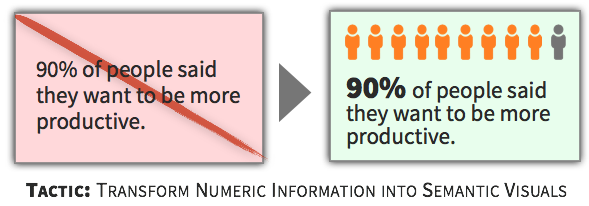
Motivating Your Readers
Conveying your message is important. No doubt. However, your copy will usually have an underlying goal.
Oftentimes, you’ll want readers to complete an action — whether it’s buying your product, donating money, or caring about your cause.
This section can help. You’ll learn a few copywriting tips that can influence readers to complete your call-to-action.
Resources for Overachievers:
- 5 Copywriting Strategies that Will Improve Your Conversion Rate by 113{11064b5fcb42990caf99fbbde3221f4b4a59d98cf45d0bc9c34fdbe4de1fd93a} — Neil Patel
- Do You Know What Your Prospects Are Really Thinking? — Heather LLoyd-Martin
- How to Use Scarcity to Get Lazy People to Act (Without Being Shady) — Demian Farnworth
Trigger a Positive Emotion
You just learned some techniques to boost the clarity of your writing. With a greater ease of processing, your readers indirectly experience a positive emotion (that will be misattributed to you and your content).
In this section, you’ll learn a few copywriting tips to directly trigger a positive emotion in your reader.
Tactic 11: Incorporate Your Reader’s Name
As humans, we experience implicit egotism, a natural tendency to be self-centered. We nonconsciously gravitate toward stimuli that resemble ourselves.
- People named Dennis are more likely to become dentists (Pelham, Mirenberg, & Jones, 2002)
- People named Louis are more likely to live in St. Louis (Pelham, Mirenberg, & Jones, 2002)
- People named Jonathan consumed a larger portion of a drink called “Joitoki” (Holland et al., 2009)
Upon hearing your own name, certain brain regions become activated — including the middle frontal cortex, middle and superior temporal cortex, and cuneus (Carmody & Lewis, 2006).
Apply that insight to your copy. By incorporating your reader’s name, you’ll trigger a positive emotion, enhancing the perception of your message.
If you send email blasts, don’t forget to use the merge field options. Not only should you insert people’s name into the header of the email, but you should also sprinkle their name throughout the body of your email.

Tactic 12: Use 1st Person Plural Pronouns
We’re also influenced by ingroups — people who share a similar social identity (Van Bavel, Packer, & Cunningham, 2008).
Perdue et al. (1990) studied the impact of language and ingroups. They showed participants various nonsense syllables, such as:
- xeh
- yof
- laj
The researchers paired each nonsense syllable with a pronoun — either an ingroup pronoun (e.g., “us”) or an outgroup pronoun (e.g., “them”).
Even though participants couldn’t remember the specific pairings, they developed an unconscious preference for nonsense syllables that were paired with an ingroup pronoun.
When you use 1st person plural pronouns (e.g., us, we our), you trigger a subtle — yet positive — emotional response in your readers. Those positive emotions will then become misattributed to your content.
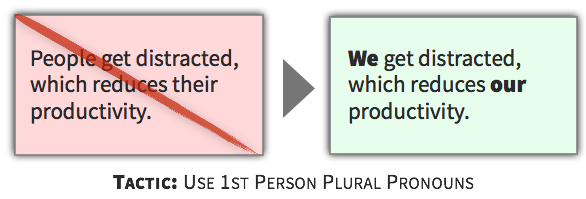
Deemphasize Your Persuasion
Persuasion strategies should always be subtle. If readers feel like you’re trying to persuade them, they develop psychological reactance (Brehm, 1966). Instead of listening to your arguments with an open mind, they resist your persuasion attempt.
To prevent that reactance, be stealthy. How? This section will explain a few tactics that will disguise your persuasion attempt — without being manipulative.
Tactic 13: Emphasize Their Freedom to Choose
Carpenter (2013) analyzed 42 different persuasion studies. Turns out, you can make a powerful impact with four simple words:
“…but you are free…” (BYAF)
In the original study, Guégen and Pascual (2000) asked people on the street to donate money. The researchers quadrupled the amount of compliance when they incorporated the BYAF phrase, “…but you are free to accept or refuse.”
When writing copy, always emphasize your reader’s freedom to choose:
- It’s up to you…
- It’s your call…
- You can decide…
That framing reduces psychological reactance. With more freedom, your readers will develop a stronger genuine desire to complete your call-to-action.

Tactic 14: Describe the Drawbacks of Your Message
Some copywriters are scared to include drawbacks in their copy. And it makes sense. If you want people to complete your call-to-action, why would you describe negative features? Seems counterproductive.
Nevertheless, research shows that two-sided arguments are more persuasive (Rucker, Petty, & Brinol, 2008).
TWO-SIDED ARGUMENT – An argument that gives benefits and drawbacks
That’s why you see companies like Amazon displaying both positive and negative reviews up front:
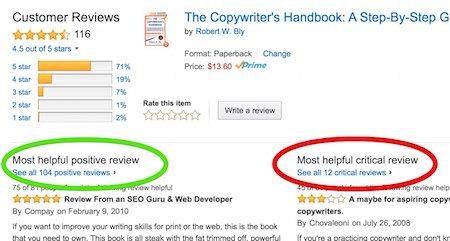
When you present both sides of an argument, people perceive you to be more rational. It seems like you chose a side carefully. So readers feel more comfortable joining your side.
You’ll also take advantage of the spotlight effect (Heath & Heath, 2013). We tend to focus on information in front of us, while ignoring information offstage. By incorporating some negative information, your readers will assume that those drawbacks are the only drawbacks to your argument.
But here’s a caveat. You should give your drawbacks a positive spin.
For example, you can use this tactic to reinforce your target market. Explain that your offering doesn’t include a particular feature because you focused more attention in another area — an area that’s more important to your target market.
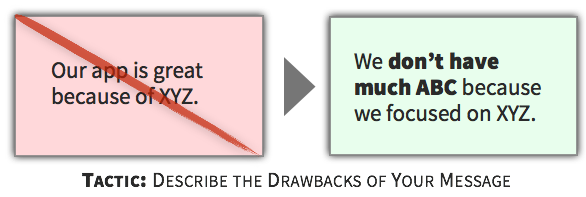
Tactic 15: Mention the Competing Alternatives
As humans, we usually determine our attitudes based on our behavior:
- If we’re eating, we infer that we’re hungry
- If we’re smiling, we infer that we’re happy
- If we’re sitting upright, we infer that we’re confident
Even if we weren’t experiencing those emotions, the mere behavior triggers those emotions within us (Wilson, 2002).
How does that relate to copywriting? If you don’t mention your competition, readers are more likely to search for competing solutions. That’s bad.
In the mere act of searching, people are more likely to infer that your solution is less attractive (Ge, Brigden, & Häubl, 2015).
However, by mentioning your competition, you prevent that search from happening. Readers feel like they’ve already done their homework, so they’re more likely to stick with your solution.
When mentioning the competition, don’t admit defeat. Simply mention the alternatives so that you can explain the difference(s) in your solution.

Tactic 16: Prolong the Start of Your Pitch
When we write copy, we feel a natural urge to emphasize our solution. And why wouldn’t we? If we want readers to complete our call-to-action, shouldn’t we describe the benefits of it?
Absolutely. But…never start your pitch immediately. Always disarm your readers first.
When people start reading your copy, they shouldn’t recognize an underlying motive or call-to-action. If readers sense that you’re trying to persuade them, they’ll be more likely to reject your benefits and arguments (Petty & Cacioppo, 1979).
So what do you do? Start by agitating the problem. Explain why the underlying problem is difficult or painful. Once you hook them in, THEN reveal your solution.
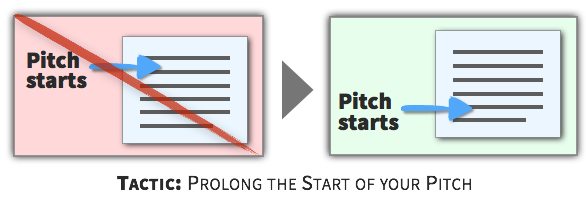
Tactic 17: Use Indirect Claims to Extract Inferences
If you’re a seasoned copywriter, you’ve heard the advice. Write copy that is clear and direct.
Sound familiar?
So then…why do you rarely see direct claims?
Flip through a magazine. You’ll never see an ad saying, “Tide will clean your clothes really well.”
Sure, you could argue that those words don’t grab attention. And that’s true.
But direct claims are also less persuasive. Why? The answer involves self-generated inferences (see McQuarrie & Phillips, 2005).
- Direct claims are explicit. There’s no other interpretation.
- Indirect claims — such as metaphors — require interpretation. We infer meaning. And that’s key. By making an inference, WE generate the meaning.
Compare these headlines:
- DIRECT: Tide will clean your clothes really well
- INDIRECT: The freshness of the outdoors. Now in liquid form.
With the DIRECT headline, there’s no other meaning. Thus, you need to rely on the information source (i.e., the biased advertiser)
With the INDIRECT headline, YOU construct the meaning. You might imagine the outdoors, associating a brisk and refreshing emotion with Tide. Regardless of the inference, YOU generate the meaning. YOU become the source. So your brain places more trust in the information.
You don’t need to use metaphors or figurative language. You just need to adjust your syntax. For example, if I wanted to pitch my book, Methods of Persuasion, I could emphasize the benefits indirectly:
- DIRECT: “My book is jam-packed with actionable content.”
- INDIRECT: “My blog articles are jam-packed with actionable content. My book is no different.”
In the first example, I say that my book is jam-packed with actionable content. It’s a direct claim. There’s no missing gap.
In the second example, I use logical reasoning to extract a self-generated inference. I essentially say that A=B and C=A (to imply that C=B):
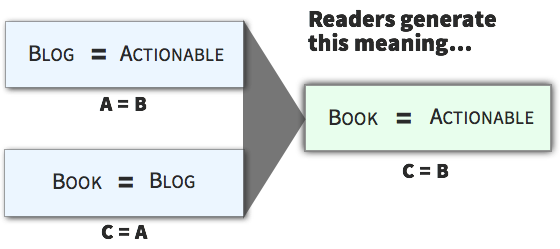
Agitate the Problem
Your solution should always relieve some type of pain that the reader is experiencing. If you want readers to appreciate your solution, you need to remind them of the pain.
So poke the wound. Show that it hurts. Before revealing your solution, agitate the underlying problem:
- Why is it important?
- Why is it problematic?
- How is it negatively affecting readers?
Then reveal your solution.
We’re biologically structured to avoid pain. So if you can trigger that feeling of pain, your readers will be more likely to pursue your solution.
This section will explain a few copywriting tips to agitate the problem.
Tactic 18: Emphasize Their Disdain for the Problem
Opposing attitudes can be stronger than supporting attitudes.
For example, we show stronger support for political candidates when our attitude is framed as opposing the other candidate, rather than supporting the original candidate (Bizer & Petty, 2005).
Instead of convincing readers about the benefits of your solution, emphasize their disdain for the underlying problem.
If you’re writing copy to promote your productivity app, don’t start with benefits. Start with the negative emotions that readers experience from a lack of productivity:
- You feel stressed and overwhelmed
- You feel like there aren’t enough hours in the day
- You miss important deadlines
- Your boss thinks you’re incompetent
- You spend less time with your family
Readers begin empathizing with those descriptions. They imagine themselves experiencing those negative emotions. They become frustrated with those problems.
Once they develop that opposition, then present your solution.
If your copy starts with your solution, you’ll kill that empathy process. Readers will become closed-minded, resisting any benefits that you offer. So always start by emphasizing your reader’s disdain for the underlying problem.

Tactic 19: Ask Rhetorical Questions to Engage Readers
Do you ever use rhetorical questions in your writing — like this one? If not, you should.
On the surface, they seem innocent. But don’t be fooled. Rhetorical questions make your arguments more persuasive (Petty, Cacioppo, & Heesacker, 1981).
Why are they more persuasive? Because they generate an implicit response:
“Rhetorical questions tend to invite a response from the message recipient, overt or otherwise…[This] may increase the certainty of one’s attitudes through an implicit response.” (Blankenship & Craig, 2006, pp. 124)
Through their implicit response, readers consider your arguments more carefully. They become engaged. Assuming that your arguments are valid, readers will be more persuaded by them.

Tactic 20: Use 2nd Person Pronouns
Earlier, I mentioned the benefits of incorporating your reader’s name into the copy.
When you can’t use that technique, you can achieve similar effects by using 2nd person pronouns, such as you and your.
Burnkrant and Unnava (1995) tested that assumption by giving participants different messages in a calculator advertisement:
- FRAME 1: “If a mistake was made…”
- FRAME 2: “You know that calculator technology…”
The second frame — because it used “self-referencing” language — generated a more favorable evaluation of the calculator.
Those 2nd person pronouns enhanced the relevance of the issue, thereby agitating the problem more effectively.

Tactic 21: Demonstrate an Impact on Other People
Self-referencing language can be very persuasive. However, you can achieve an equally — if not more — powerful effect by demonstrating an impact on other people. Especially when the impact is negative.
Consider two message that were presented in a hospital:
- FRAME 1: Hand hygiene prevents you from catching diseases.
- FRAME 2: Hand hygiene prevents patients from catching diseases.
The second frame influenced more hospital staff to wash their hands (Grant & Hoffman, 2011).
When possible, explain how other people will be negatively affected if readers don’t complete your call-to-action.

Tactic 22: Label Your Readers with a Noun
Nouns generate stronger and more stable preferences. For example, Walton and Banaji (2004) gave participants various statements:
- Jennifer drinks coffee a lot
- Jennifer spends a lot of time indoors
- Jennifer watches baseball a lot
Those statements emphasize verbs. They answer the question: what does Jennifer do?
The researchers gave different statements to other participants:
- Jennifer is a coffee-drinker
- Jennifer is an indoors person
- Jennifer is a baseball fan
Those statements emphasize nouns. They answer the question: who is Jennifer?
Both sets of statements convey the same meaning. However, the second set generated a stronger impact. With nouns, those traits seemed central to Jennifer’s identity.
How can you use that tactic? For one, you could label your audience with a funky noun (any Beliebers reading this?). But you don’t need to go that far.
Here’s a simpler idea. If you’re a blogger, instead of thanking readers for doing something (e.g., reading your content), thank them for being something (e.g., being a fan of your content). That second frame will generate a stronger impact on their attitude toward your content.

Tactic 23: Properly Frame a Length of Time
Which seems longer:
- 7-21 days
- 1-3 weeks
Both durations are the same. So which one generates a larger impact? Monga and Bagchi (2012) argue that it depends on the immediacy of the decision:
- IMMEDIATE DECISIONS: People develop a concrete mindset. In turn, they place greater weight on NUMERALS.
- DISTANT DECISIONS: People develop an abstract mindset. In turn, they place greater weight on UNITS.
Once you identify the immediacy of your decision, adjust the framing of your numbers and units:
“If units are salient, managers ought to use large units to magnify positive changes (e.g., increase in fiber content) or small units to understate negative changes (e.g., increase in delivery time). If numbers are salient, they ought to do the opposite.”(Monga & Bagchi, 2012, pp. 186)
Consider the shipping time for an online purchase. During the purchase process (i.e., an immediate event), customers will be focused on numerals. So you should minimize those numbers (e.g., 1-3 weeks). Afterward, when customers are waiting for the delivery (i.e., a distant event), they’ll be focused on units. So you should minimize the units (e.g., 7-21 days).
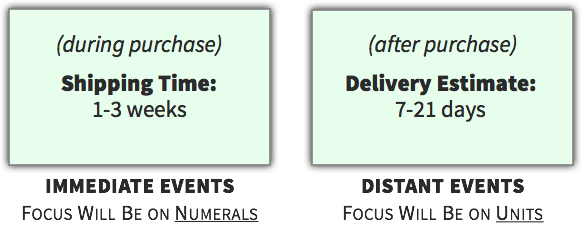
Tactic 24: Reference an Upcoming Point of Closure
Most humans experience a need for closure (Krugalinski & Webster, 1996). When we face ambiguity, we seek comprehension.
Exploit that tendency in your copy. To keep readers engaged, follow these steps:
- STEP 1: Make an ambiguous statement to spark curiosity
- STEP 2: Reference an upcoming point of closure
Here are some examples of different openers.
- Last year, I suffered a near-fatal heart attack. More on that later.
- In 2013, I sold all of my possessions. I’ll explain why soon.
- With a clever technique, I made $53k from affiliate marketing. You’ll see how in a few paragraphs.
The first statement will trigger their curiosity for an explanation (you can choose any “shocking” anecdote — as long as you connect it to your offering). The second statement will incentivize readers to stay engaged to resolve that ambiguity.

Provide the Proper Support
Once you’ve agitated the problem, then — and only then — should you start your pitch. This strategy will teach you the best way to present your offering and persuade readers to complete your call-to-action.
Tactic 25: Match Their Promotion / Prevention Mindset
Why are people completing your call-to-action? Are they trying to gain something or prevent something?
Consider your productivity app. Why is your target market buying it?
- PROMOTION: To be more efficient
- PREVENTION: To prevent feeling overwhelmed
Your copy should match their mindset.
With congruent copy, you increase processing fluency (Lee, Keller, & Sternthal, 2010). People can digest your message more easily, so they experience a stronger reaction to it.
Ideally, you should be capturing the exact wording from interviews with your target customers. Once you know their mindset, you can agitate the problem more effectively:
- If customers want to gain efficiency, explain how your app can help them accomplish more tasks in less time
- If customers want to prevent feeling overwhelmed, explain how your app can alleviate the stress that they’re feeling
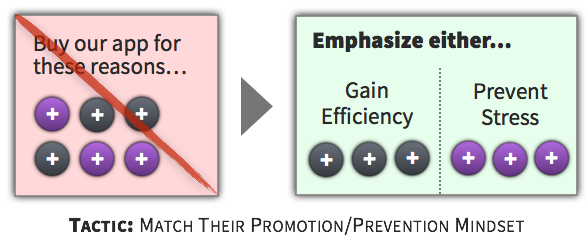
Tactic 26: Avoid Hedges, Disclaimers, and Tag Questions
You want to deemphasize your persuasion attempt. However, you don’t want to use weak language.
Here are some examples:
Hedges
- Possibly
- Seems
- Might
Disclaimers
- “I’m not positive, but I think…”
- “I’m not an expert, but…”
- “It could go either way, but…”
Tag Questions
- “…don’t you think?”
- “…wouldn’t it?
- “…right?”
If your main goal is conveying information (e.g., through a blog article), you can use those phrases if you want to seem unbiased.
However, if your main goal is persuasion, you should avoid those hedges, disclaimers, and tag questions — all of which reduce the persuasiveness of your offer (Blankenship & Holtgraves, 2005).

Tactic 27: Include Words That Signal Justification
In Thinking Fast and Slow, Kahneman popularized the sheer extent of our irrationality.
We believe that our decisions are based on careful reasoning. But that’s not the case. Most of our decisions — even important ones — are quick and mindless.
Justification is a great example.
When an argument contains any justification, we mindlessly assume that the justification is valid (so we’re more persuaded by it).
Even if two arguments contain the same reasoning, merely including the word “because” will make one argument stronger than the other (Langer, Blank & Chanowitz, 1978).
But you don’t need to rely on the word “because.” Since the real culprit is justification, you can use other words that trigger the perception of justification:
- You should do XYZ, so that…
- You should do XYZ due to…
- Since _______, you should do XYZ.
When most readers encounter those signals, they’ll automatically assume that your justification is valid.
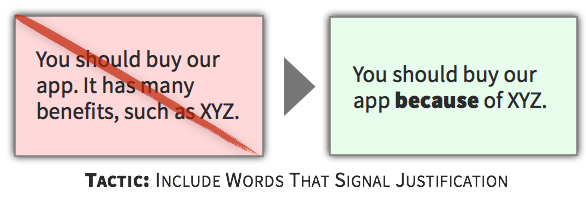
Tactic 28: Position Strong Benefits Toward the Beginning
Don’t overlook the sequencing in your message. Always position strong benefits toward the beginning of your message.
You might be familiar with the primacy effect — information has a stronger impact when it’s presented at the beginning of a sequence (Murdock, 1962).
When your first benefit is strong, you raise expectations for the remaining information. Those expectations, in turn, generate a more favorable perception.
Your initial arguments will also generate a stronger impact on long-term memory. When readers recall the benefits of your solution, they’ll be more likely to remember the initial reasons that you gave. So you want those reasons to be strong.
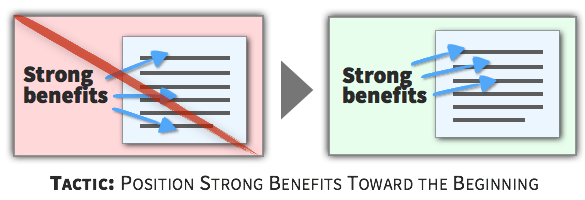
Tactic 29: For Prevention Needs, Use Side-By-Side Comparisons
People evaluate information differently — depending on promotion vs. prevention needs.
- With PREVENTION needs, people focus on ACCURACY
- With PROMOTION needs, people focus on PROGRESS
In turn, certain argument styles are more effective.
Wan, Hong, and Sternthal (2009) found that simultaneous arguments (e.g., comparison tables) work better for prevention needs. Those side-by-side comparisons reinforce the accuracy of the decision.
Conversely, sequential arguments (e.g., lists of benefits) work better for promotion needs. Those consecutive structures mimic the perception of progress.
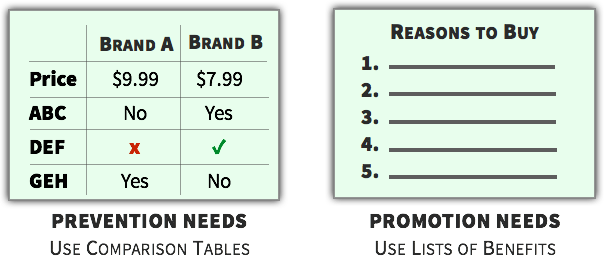
Tactic 30: For Immediate Decisions, Use “Prevention” and “How” Frames
When writing copy, consider the decision timeline. When do readers need to act? That answer should dictate the framing in your copy.
Mogilner, Aaker, & Pennington (2008) found that people value different criteria — depending on the decision timeline:
- IMMEDIATE DECISIONS: People worry about reaching a goal (i.e., feasibility)
- DISTANT DECISIONS: People worry about reaching a pleasurable goal (i.e., desirability)
Your copy should agitate those pain points.
For example, Mogilner, Aaker, & Pennington (2008) tested different ad framing — prevention vs. promotion —for a travel service.
- PREVENTION ads performed better for IMMEDIATE decisions (i.e., last-minute vacations). This framing agitates the feasibility.
- PROMOTION ads performed better for DISTANT decisions (i.e., vacations that were months away). This framing agitates the desirability.
When the ad copy matched their mindset, people were willing to pay a higher price for the travel service.
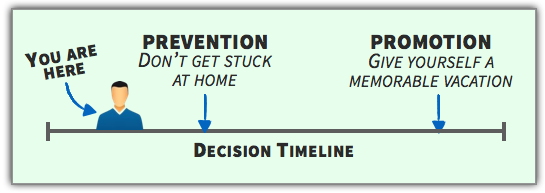
Likewise, the decision timeline could also influence your choice of “how” vs. “why” framing. For example, Kim, Rao, & Lee (2009) found that political candidates perform better when “how” appeals are closer to the voting decision:
“In three experiments, we show that abstract, “why” laden appeals are more persuasive than concrete, “how” laden appeals when voters’ decision is temporally distant, and the reverse is true when the decision is imminent…” (Kim, Rao, & Lee, 2009, pg. 1)
A productivity app would be a simple — usually immediate — purchase decision. Thus, you should emphasize a “prevention” frame to agitate feasibility. You could explain “how” the app increases productivity (i.e., feasibility of benefits). Or you could outline steps on “how” to buy the app (i.e. feasibility of purchase).
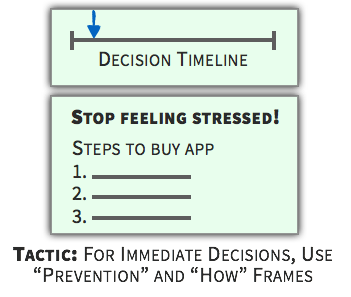
Tactic 31: Reduce the Inherent Type of Risk
Don’t write copy haphazardly.
Rather than spew random information, choose arguments that will generate the strongest impact.
So…which arguments should you choose? You’ll want arguments that minimize risk. And every situation has different types of risk.
For example, Lantos (2011) describes 9 types of risk. Identify your risk. Then adjust your copy accordingly.
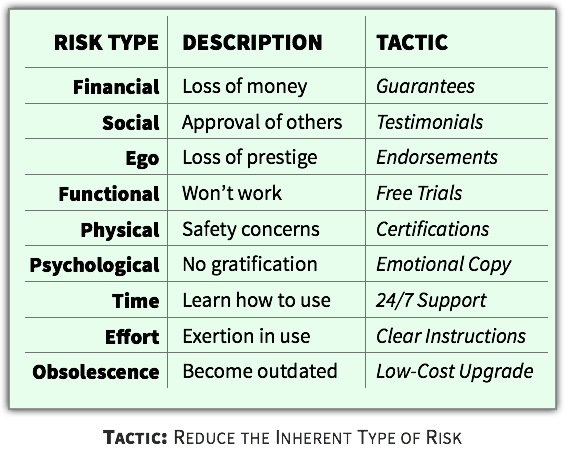
Conclusion
Copywriting is a science. With a few small changes, you can make a large impact on the persuasiveness of your message.
But you should be realistic. At the end of the day, writing is still an art.
You can’t transform a crappy painting into a masterpiece with a few brush strokes. Likewise, you can’t transform crappy copy into a persuasive message with a few minor tweaks. You need good copy at the heart of your message.
If you can’t write compelling copy, you should make that goal a priority. Pick up some books to improve your writing skills:
- The Elements of Style by William Strunk and E.B. White
- On Writing Well by William Zinsser
- The Only Grammar Book You’ll Ever Need by Susan Thurman
- Everybody Writes by Ann Handley
Once you have those foundational skills, then you can make those extra tweaks to maximize the impact of your message.
And if you’re still hungry for more copywriting content, you might enjoy my article on the psychology of stock photos.
Final Note
Unfortunately, I’m at a disadvantage by discussing persuasive writing. If I end with a call-to-action (and use the tactics from this article), then I’ll look sleazy. Whoops. Not very conducive.
So I’ll just end with a straightforward call-to-action. If you enjoyed the article, then you’ll enjoy my other content. You can subscribe to my blog by downloading the full PDF + checklist.
